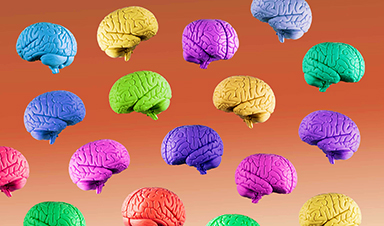Does the advent of machine learning mean the classic methodology of hypothesize, predict and test has had its day?
Isaac Newton apocryphally discovered his second law – the one about gravity – after an apple fell on his head. Much experimentation and data analysis later, he realised there was a fundamental relationship between force, mass and acceleration. He formulated a theory to describe that relationship – one that could be expressed as an equation, F=ma – and used it to predict the behaviour of objects other than apples. His predictions turned out to be right (if not always precise enough for those who came later).
Contrast how science is increasingly done today. Facebook’s machine learning tools predict your preferences better than any psychologist. AlphaFold, a program built by DeepMind, has produced the most accurate predictions yet of protein structures based on the amino acids they contain. Both are completely silent on why they work: why you prefer this or that information; why this sequence generates that structure.
You can’t lift a curtain and peer into the mechanism. They offer up no explanation, no set of rules for converting this into that – no theory, in a word. They just work and do so well. We witness the social effects of Facebook’s predictions daily. AlphaFold has yet to make its impact felt, but many are convinced it will change medicine.
Somewhere between Newton and Mark Zuckerberg, theory took a back seat. In 2008, Chris Anderson, the then editor-in-chief of Wired magazine, predicted its demise. So much data had accumulated, he argued, and computers were already so much better than us at finding relationships within it, that our theories were being exposed for what they were – oversimplifications of reality. Soon, the old scientific method – hypothesize, predict, test – would be relegated to the dustbin of history. We’d stop looking for the causes of things and be satisfied with correlations.
With the benefit of hindsight, we can say that what Anderson saw is true (he wasn’t alone). The complexity that this wealth of data has revealed to us cannot be captured by theory as traditionally understood. “We have leapfrogged over our ability to even write the theories that are going to be useful for description,” says computational neuroscientist Peter Dayan, director of the Max Planck Institute for Biological Cybernetics in Tübingen, Germany. “We don’t even know what they would look like.”
But Anderson’s prediction of the end of theory looks to have been premature – or maybe his thesis was itself an oversimplification. There are several reasons why theory refuses to die, despite the successes of such theory-free prediction engines as Facebook and AlphaFold. All are illuminating, because they force us to ask: what’s the best way to acquire knowledge and where does science go from here?
The first reason is that we’ve realised that artificial intelligences (AIs), particularly a form of machine learning called neural networks, which learn from data without having to be fed explicit instructions, are themselves fallible. Think of the prejudice that has been documented in Google’s search engines and Amazon’s hiring tools.
The second is that humans turn out to be deeply uncomfortable with theory-free science. We don’t like dealing with a black box – we want to know why.
And third, there may still be plenty of theory of the traditional kind – that is, graspable by humans – that usefully explains much but has yet to be uncovered.
So theory isn’t dead, yet, but it is changing – perhaps beyond recognition. “The theories that make sense when you have huge amounts of data look quite different from those that make sense when you have small amounts,” says Tom Griffiths, a psychologist at Princeton University.
Griffiths has been using neural nets to help him improve on existing theories in his domain, which is human decision-making. A popular theory of how people make decisions when economic risk is involved is prospect theory, which was formulated by behavioural economists Daniel Kahneman and Amos Tversky in the 1970s (it later won Kahneman a Nobel prize). The idea at its core is that people are sometimes, but not always, rational…..
News
Nerve Damage Can Disrupt Immunity Across the Entire Body
A single nerve injury can quietly reshape the immune system across the entire body. Preclinical research from McGill University suggests that nerve injuries may lead to long-lasting changes in the immune system, and these [...]
Fake Science Is Growing Faster Than Legitimate Research, New Study Warns
New research reveals organized networks linking paper mills, intermediaries, and compromised academic journals Organized scientific fraud is becoming increasingly common, ranging from fabricated research to the buying and selling of authorship and citations, according [...]
Scientists Unlock a New Way to Hear the Brain’s Hidden Language
Scientists can finally hear the brain’s quietest messages—unlocking the hidden code behind how neurons think, decide, and remember. Scientists have created a new protein that can capture the incoming chemical signals received by brain [...]
Does being infected or vaccinated first influence COVID-19 immunity?
A new study analyzing the immune response to COVID-19 in a Catalan cohort of health workers sheds light on an important question: does it matter whether a person was first infected or first vaccinated? [...]
We May Never Know if AI Is Conscious, Says Cambridge Philosopher
As claims about conscious AI grow louder, a Cambridge philosopher argues that we lack the evidence to know whether machines can truly be conscious, let alone morally significant. A philosopher at the University of [...]
AI Helped Scientists Stop a Virus With One Tiny Change
Using AI, researchers identified one tiny molecular interaction that viruses need to infect cells. Disrupting it stopped the virus before infection could begin. Washington State University scientists have uncovered a method to interfere with a key [...]
Deadly Hospital Fungus May Finally Have a Weakness
A deadly, drug-resistant hospital fungus may finally have a weakness—and scientists think they’ve found it. Researchers have identified a genetic process that could open the door to new treatments for a dangerous fungal infection [...]
Fever-Proof Bird Flu Variant Could Fuel the Next Pandemic
Bird flu viruses present a significant risk to humans because they can continue replicating at temperatures higher than a typical fever. Fever is one of the body’s main tools for slowing or stopping viral [...]
What could the future of nanoscience look like?
Society has a lot to thank for nanoscience. From improved health monitoring to reducing the size of electronics, scientists’ ability to delve deeper and better understand chemistry at the nanoscale has opened up numerous [...]
Scientists Melt Cancer’s Hidden “Power Hubs” and Stop Tumor Growth
Researchers discovered that in a rare kidney cancer, RNA builds droplet-like hubs that act as growth control centers inside tumor cells. By engineering a molecular switch to dissolve these hubs, they were able to halt cancer [...]
Platelet-inspired nanoparticles could improve treatment of inflammatory diseases
Scientists have developed platelet-inspired nanoparticles that deliver anti-inflammatory drugs directly to brain-computer interface implants, doubling their effectiveness. Scientists have found a way to improve the performance of brain-computer interface (BCI) electrodes by delivering anti-inflammatory drugs directly [...]
After 150 years, a new chapter in cancer therapy is finally beginning
For decades, researchers have been looking for ways to destroy cancer cells in a targeted manner without further weakening the body. But for many patients whose immune system is severely impaired by chemotherapy or radiation, [...]
Older chemical libraries show promise for fighting resistant strains of COVID-19 virus
SARS‑CoV‑2, the virus that causes COVID-19, continues to mutate, with some newer strains becoming less responsive to current antiviral treatments like Paxlovid. Now, University of California San Diego scientists and an international team of [...]
Lower doses of immunotherapy for skin cancer give better results, study suggests
According to a new study, lower doses of approved immunotherapy for malignant melanoma can give better results against tumors, while reducing side effects. This is reported by researchers at Karolinska Institutet in the Journal of the National [...]
Researchers highlight five pathways through which microplastics can harm the brain
Microplastics could be fueling neurodegenerative diseases like Alzheimer's and Parkinson's, with a new study highlighting five ways microplastics can trigger inflammation and damage in the brain. More than 57 million people live with dementia, [...]
Tiny Metal Nanodots Obliterate Cancer Cells While Largely Sparing Healthy Tissue
Scientists have developed tiny metal-oxide particles that push cancer cells past their stress limits while sparing healthy tissue. An international team led by RMIT University has developed tiny particles called nanodots, crafted from a metallic compound, [...]





















